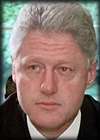 London, November 2, 1999
Editorial Kosovo's
Corpse Count How many bodies make
a genocide? THE forensic experts
who have been in Kosovo since Nato's
bombing campaign ended in June, unearthing
grisly evidence of mass murder that Nato's
wartime reports indicated, are reaching a
surprising conclusion. The number of ethnic Albanians murdered
or executed during the springtime
hostilities may be lower than at first
suspected -- perhaps in the hundreds, not
tens of thousands. The good-hearted might
treat this as cause for rejoicing. Instead
it has been taken up as a stick with which
to beat Nato. Critics suggest that Nato
officials deliberately made up the
accusation that the Yugoslav President,
Slobodan Milosevic, planned the
destruction of Kosovo Albanians. The
accusation of genocide was sometimes used
as moral justification for intervention.
If it is not now backed by vast numbers of
mass graves, critics allege that those who
backed Nato were the victims of a con
trick.  The
picture that Nato officials painted during
the war of events inside Kosovo was,
legitimately, as dark as available
information permitted. The US Defence
Secretary, William Cohen, said that
up to 100,000 Albanians had been killed by
the Yugoslav military. Geoff Hoon,
then Minister of State at the Foreign
Office, said that 10,000 had been killed.
President Clinton said tens of
thousands had been killed on President
Milosevic's orders. The UN told experts
from 15 countries who were later sent into
the province to expect 44,000 deaths. The
picture that Nato officials painted during
the war of events inside Kosovo was,
legitimately, as dark as available
information permitted. The US Defence
Secretary, William Cohen, said that
up to 100,000 Albanians had been killed by
the Yugoslav military. Geoff Hoon,
then Minister of State at the Foreign
Office, said that 10,000 had been killed.
President Clinton said tens of
thousands had been killed on President
Milosevic's orders. The UN told experts
from 15 countries who were later sent into
the province to expect 44,000 deaths.
Yet the very
disparity between these estimates was,
even at the time, an indication that no
one could realistically evaluate what
was going on on the ground. During an
air campaign in which much of Kosovo's
Albanian majority fled both Serbs and
bombs, either to take shelter in
refugee camps abroad or to mill
helplessly about inside their homeland
-- seeking a way out not barred by
Serbs with guns -- the closest
approximation to the truth was the
stories of refugees. Traumatised
refugees may describe their escape, or
fears for relatives in danger, with
more emotional than factual truth.
Misunderstandings must be expected. It
was precisely because war engenders
confusion and conspiracy theories that
experts were ordered in to establish
amore clinical truth. Those experts have since lowered the
death figures several times, According to
Emilio Perez Pujol, head of a
Spanish team which went home in disgust
last month after finding just 187 bodies,
there may be even fewer victims than the
11,000 of the latest Nato estimate.
Several sites
publicised by Nato as possible mass graves
turn out to be empty. Stratfor,
an analytical group examining data from
Kosovo, suggests that the final toll might
be as low as a few hundred. This less bloodstained picture
undoubtedly discredits the individuals who
rushed to bandy exaggerated accusations of
"genocide"; reality cannot keep up with
their hyperbole. But it does nothing to
invalidate Nato's rationale for fighting.
Intervention was necessary to stop Serb
forces committing mass atrocities; Mr
Milosevic had resisted all non-military
pressure. Serb forces were moving the
Albanian population out of the province.
The actual number of civilians killed to
scare the rest off is irrelevant; the
prevention of mass murder and ethnic
cleansing, on whatever scale, remains a
war aim of which Nato can be
proud. |